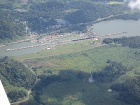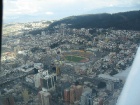|
Even though we'd refueled the day before to
save time on the day of our departure, there were delays paying the
landing fee due to reduced staff, and we also had to spend some time in
the Mapiex office to get a print-out of the Ecuador permit. The Peru
permit had only been verbally confirmed so it was agreed they would send
it to us via email.
So, in spite of making an early start, we didn't take off until 10:08
local time. We had a 4-and-a-half-hour flight to Quito ahead of us and
we knew that the further into the afternoon we arrived, the more clouds
and mountain CB’s there would be on the approach into Quito airport.
From the METAF for Quito, we had expected to cancel IFR by the coast to
avoid the high minimum altitudes required for IFR into Quito.
When we arrived by the coast, we were on top of a solid overcast and
could not even see the 16’000 foot peak just west of Quito. This meant
we would need to do an instrument approach and for that we had to climb
to 17,000 feet, which with tropical temperatures meant a density
altitude close to 20’000 feet. Fortunately we were light. Due to the
high elevation of Quito airport, we needed to be as light as possible on
departure from Quito, so Flemming had only refueled enough to get us to
nearby Ibarra and to Guayaquil. This was the first time in Flemming's
4000 hours of flying that he actually had to use oxygen on the approach!
When we took the time during the flight to read the Ecuador permit that
Mapiex had obtained for us, we saw that Ibarra was not down there in
print, although we had been told it was included. Also, although
permission had been granted to fly to Baltra (Galapagos), the
authorization did not include parking there for a week. So, before
taking a taxi to the city, we went to talk to the Operaciones official.
He was most courteous, helpful and efficient. Ibarra was no problem, he
said and, as for Baltra, he made a quick call to the person in charge
there. The problem with Baltra airport is that there is only limited
parking space, but he insisted that the Mooney was only a small plane
and could be fitted in a corner somewhere. Verbal approval was given.
Just to be on the safe side, we asked him to add a record of the phone
call by hand onto our printout of the Ecuador authorization, which he
signed. Altogether a much smoother arrival in Ecuador than we’d
expected.
Our stay in Quito was short and sweet consisting of a cosy ‘boutique’
hotel called Vieja Cuba, a good Ecuadorian style bouillabaise in
reportedly Quito’s best fish restaurant, and next morning a taxi ride to
the old city with its fine collection of churches, dripping with gold.
The Spanish didn’t waste time in imposing their culture on the
indigenous population, erecting churches within a few years of their
arrival, so several of the edifices dated back to the 16th century.
|

Aerial view of Miraflores locks on departure from Panama City
|

Aerial view of Quito on final
|



